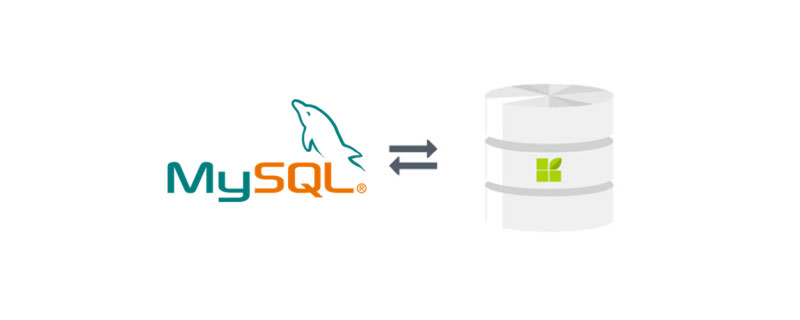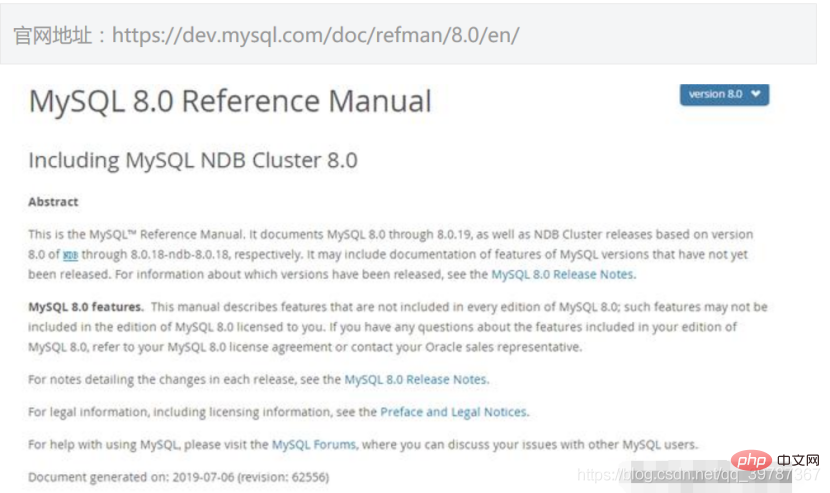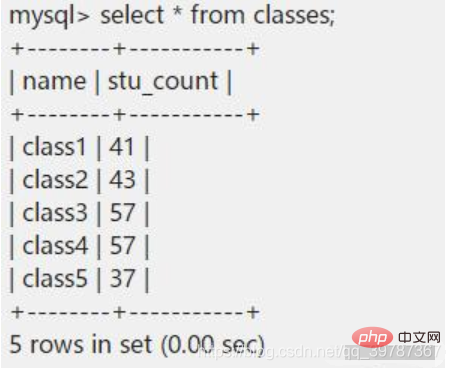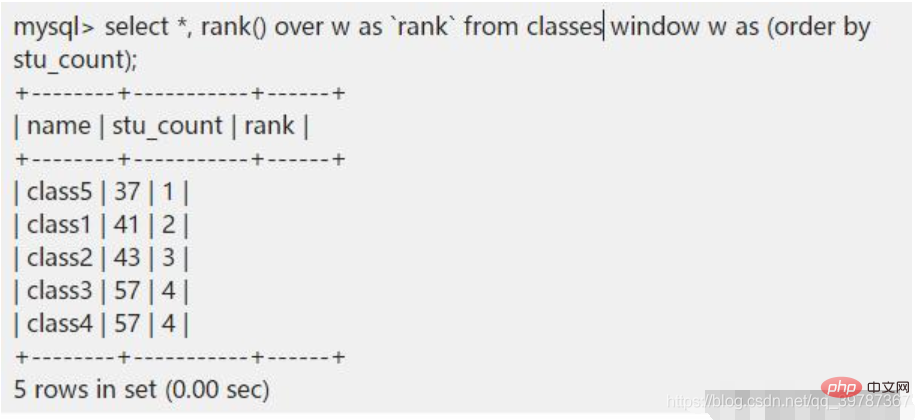What are the differences between Mysql8 and mysql5.7
This article will introduce to you the difference between Mysql8 and mysql5.7. It has certain reference value. Friends in need can refer to it. I hope it will be helpful to everyone.

1. NoSql storage
Mysql has provided NoSQL storage function since version 5.7. This part has been modified in 8.0, but this is not practical in practice. Very rarely used

2. Hidden index
The hidden index feature is very useful for performance debugging. In 8.0, the index can be hidden and displayed. When an index is hidden, it will not be used by the query optimizer

#That is to say, you can hide an index and observe the impact on the database. If performance drops, It means that this index is valid, so just "restore display"; if the database performance does not change, it means that this index is too large and can be deleted.
Syntax for hiding an index
ALTER TABLE t ALTER INDEX i INVISIBLE;
The syntax for restoring the display of the index is:
ALTER TABLE t ALTER INDEX i VISIBLE;
When an index is hidden, we can see from the output summary of the show index command that the visible attribute value of the index is No
**Note:** When the index is hidden, its content is still updated in real time like a normal index. This feature itself is specially used for optimization and debugging. If you hide an index for a long time, it is better to kill it. , because the existence of the index will affect the insertion, update and deletion functions of data
3. Set persistence
MySQL settings can be changed at runtime through the SET GLOBAL command, but this change It will only take effect temporarily, and the database will be read from the configuration file the next time it is started.
MySQL 8 has added the SET PERSIST command, for example:
SET PERSIST max_connections = 500;
MySQL will save the configuration of this command to the mysqld-auto.cnf file in the data directory, and will Read this file and use the configuration in it to overwrite the default configuration file.
4.UTF-8 encoding
Starting from MySQL 8, the default encoding of the database will be changed to utf8mb4, which includes all emoji characters. For many years, we have been careful in coding when using MySQL, for fear of forgetting to change the default latin and causing garbled code problems. No more worries from now on.
5. Common Table Expressions
Complex queries will use embedded tables, for example:
SELECT t1.*, t2.* FROM (SELECT col1 FROM table1) t1, (SELECT col2 FROM table2) t2;
With CTE, we can write like this :
WITH t1 AS (SELECT col1 FROM table1), t2 AS (SELECT col2 FROM table2) SELECT t1.*, t2.* FROM t1, t2;
In this way, the levels and areas look more distinct, and it is clearer to know which part to change when making changes.
This feature is very useful in many reporting scenarios and is also a very important feature of mysql optimization.
1.235 Window Functions
One of the most criticized features of MySQL is the lack of the rank() function. When ranking needs to be achieved in a query, the @ variable must be written by hand. But starting from 8.0, MySQL has added a new concept called window function, which can be used to implement several new query methods.
The window function is a bit like an aggregate function such as SUM() and COUNT(), but it does not merge the multi-row query results into one row, but puts the results back into multiple rows. In other words, window functions do not require GROUP BY.
Suppose we have a table of "number of students in a class":

If you want to rank the class size from small to large, you can use the window function like this:

Explanation: A window named w is created here, and it is specified to sort the stu_count field, and then execute the rank() method on w in the select clause to put the result The output is the rank field.
This feature is also a new feature of Oracle11g, and it also plays a very important role in optimization.
Related recommendations: "mysql tutorial"
The above is the detailed content of What are the differences between Mysql8 and mysql5.7. For more information, please follow other related articles on the PHP Chinese website!

Hot AI Tools

Undresser.AI Undress
AI-powered app for creating realistic nude photos

AI Clothes Remover
Online AI tool for removing clothes from photos.

Undress AI Tool
Undress images for free

Clothoff.io
AI clothes remover

Video Face Swap
Swap faces in any video effortlessly with our completely free AI face swap tool!

Hot Article

Hot Tools

Notepad++7.3.1
Easy-to-use and free code editor

SublimeText3 Chinese version
Chinese version, very easy to use

Zend Studio 13.0.1
Powerful PHP integrated development environment

Dreamweaver CS6
Visual web development tools

SublimeText3 Mac version
God-level code editing software (SublimeText3)

Hot Topics
 1666
1666
 14
14
 1425
1425
 52
52
 1323
1323
 25
25
 1272
1272
 29
29
 1251
1251
 24
24
 Laravel Introduction Example
Apr 18, 2025 pm 12:45 PM
Laravel Introduction Example
Apr 18, 2025 pm 12:45 PM
Laravel is a PHP framework for easy building of web applications. It provides a range of powerful features including: Installation: Install the Laravel CLI globally with Composer and create applications in the project directory. Routing: Define the relationship between the URL and the handler in routes/web.php. View: Create a view in resources/views to render the application's interface. Database Integration: Provides out-of-the-box integration with databases such as MySQL and uses migration to create and modify tables. Model and Controller: The model represents the database entity and the controller processes HTTP requests.
 MySQL and phpMyAdmin: Core Features and Functions
Apr 22, 2025 am 12:12 AM
MySQL and phpMyAdmin: Core Features and Functions
Apr 22, 2025 am 12:12 AM
MySQL and phpMyAdmin are powerful database management tools. 1) MySQL is used to create databases and tables, and to execute DML and SQL queries. 2) phpMyAdmin provides an intuitive interface for database management, table structure management, data operations and user permission management.
 MySQL vs. Other Programming Languages: A Comparison
Apr 19, 2025 am 12:22 AM
MySQL vs. Other Programming Languages: A Comparison
Apr 19, 2025 am 12:22 AM
Compared with other programming languages, MySQL is mainly used to store and manage data, while other languages such as Python, Java, and C are used for logical processing and application development. MySQL is known for its high performance, scalability and cross-platform support, suitable for data management needs, while other languages have advantages in their respective fields such as data analytics, enterprise applications, and system programming.
 Solve database connection problem: a practical case of using minii/db library
Apr 18, 2025 am 07:09 AM
Solve database connection problem: a practical case of using minii/db library
Apr 18, 2025 am 07:09 AM
I encountered a tricky problem when developing a small application: the need to quickly integrate a lightweight database operation library. After trying multiple libraries, I found that they either have too much functionality or are not very compatible. Eventually, I found minii/db, a simplified version based on Yii2 that solved my problem perfectly.
 Laravel framework installation method
Apr 18, 2025 pm 12:54 PM
Laravel framework installation method
Apr 18, 2025 pm 12:54 PM
Article summary: This article provides detailed step-by-step instructions to guide readers on how to easily install the Laravel framework. Laravel is a powerful PHP framework that speeds up the development process of web applications. This tutorial covers the installation process from system requirements to configuring databases and setting up routing. By following these steps, readers can quickly and efficiently lay a solid foundation for their Laravel project.
 Solve MySQL mode problem: The experience of using the TheliaMySQLModesChecker module
Apr 18, 2025 am 08:42 AM
Solve MySQL mode problem: The experience of using the TheliaMySQLModesChecker module
Apr 18, 2025 am 08:42 AM
When developing an e-commerce website using Thelia, I encountered a tricky problem: MySQL mode is not set properly, causing some features to not function properly. After some exploration, I found a module called TheliaMySQLModesChecker, which is able to automatically fix the MySQL pattern required by Thelia, completely solving my troubles.
 MySQL: Structured Data and Relational Databases
Apr 18, 2025 am 12:22 AM
MySQL: Structured Data and Relational Databases
Apr 18, 2025 am 12:22 AM
MySQL efficiently manages structured data through table structure and SQL query, and implements inter-table relationships through foreign keys. 1. Define the data format and type when creating a table. 2. Use foreign keys to establish relationships between tables. 3. Improve performance through indexing and query optimization. 4. Regularly backup and monitor databases to ensure data security and performance optimization.
 MySQL: Key Features and Capabilities Explained
Apr 18, 2025 am 12:17 AM
MySQL: Key Features and Capabilities Explained
Apr 18, 2025 am 12:17 AM
MySQL is an open source relational database management system that is widely used in Web development. Its key features include: 1. Supports multiple storage engines, such as InnoDB and MyISAM, suitable for different scenarios; 2. Provides master-slave replication functions to facilitate load balancing and data backup; 3. Improve query efficiency through query optimization and index use.




